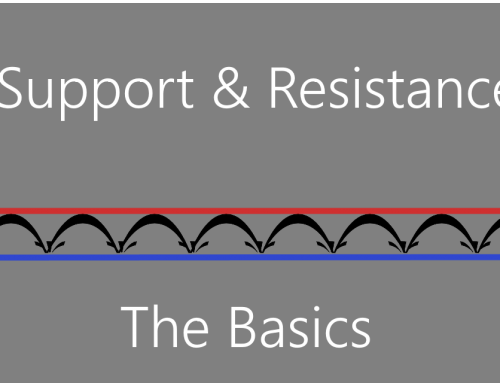Looking for direction in the markets? Well, if that’s the case, it’s worth brushing up on the technical analyst’s tool referred to as “Directional Movement.” Not only does this tool provide a backdrop for trader sentiment, it gives us another instrument in our ever-growing “bag of tricks.” But like most tools, this one takes careful evaluation in order to understand exactly what it’s telling us.
The Average Directional Indicator (ADX) can help signal when we should “jump in” and buy a particular stock or when we should “be patient” and wait to buy at better prices. (Editor’s note: RightLine Charts designates this indicator as the “DMI (modified)” or Directional Movement Indicator)
Let’s explore the intricacies of the ADX, and use what this indicator measures to help us understand it. The ADX is intended for measuring the amount of directional price movement in a stock at any particular time. Directional movement is defined as the largest part of today’s price range that occurred outside of yesterday’s range.
Picture a computer scanning a stock chart over a period of about two months. The first scan looks at each bar for any signs of upward directional price movement. If the price range today is higher than yesterday’s range, then there was some upward directional price movement. As the computer scans the chart it collects the amount of each day’s upward directional price movement and averages it into an indicator called +DI, or positive direction.
The computer then scans the data once more in search of any DOWNWARD directional movement. The negative price movement is collected and averaged into a formula for –DI, or negative direction. The +DI and the -DI are then compared to see if there is any imbalance in “directional” price movement. When substantial directional movement is detected, the ADX indicator begins to rise or fall. When there is less directional movement the ADX declines. Sounds straightforward, right?
But it’s important to understand that the ADX is measuring the AMOUNT of directional price movement, and also if there is a great deal of either positive or negative price movement. A move in EITHER direction will cause the ADX to rise. Don’t be confused by the significance of a rising ADX. A rising ADX does not necessarily mean that prices are rising. It means that the AMOUNT of “directional price movement” is increasing. The direction of that price movement can be up AS WELL AS down.
The ADX is most commonly displayed along with the +DI and -DI indicators so that a quick glance will tell us the direction of prices. These are always positive numbers; the + or – simply indicate direction. If the +DI is above the -DI it means that the direction of prices is up. If the +DI is below the -DI it means that the trend of prices is down. When the +DI and -DI begin to get farther apart, the ADX rises.
Recall that the trend is our friend when using the ADX, because this indicator will help tell us how good that friend really is! Strong trends—which occur only about 30% of the time—are generally accompanied by a rising ADX that pushes above 40, or even better, above 50. For certain, prices can be running higher without an advancing ADX. In those cases, it’s time to pull stops tighter and consider long taking profits. A trend without a rising ADX typically stalls. Likewise, as ADX drops to 40, a previously strong trend is typically running out of steam.
Now that we understand a rising ADX means that there is strong trend in prices, we should tailor our trading strategies to make good use of this valuable information. From now on lets assume that when the ADX rises we immediately check the DI indicators and determine that the rise in the ADX is being caused by an uptrend in prices. We are not going to buy when the Minus DI is greater than the Plus DI.
According to Dr. Alexander Elder’s book, “Trading for a Living” “When a trend proceeds in a healthy manner, the spread between two smoothed Directional lines increases and ADX rises.”
If we are watching a particular stock that we would like to buy we may often have a problem deciding if we should buy it now or if we should attempt to pick off a bargain and try to buy it at a lower price. Which should we do? Buy at the market before it runs away from us or wait for a dip?
This decision is made easier by simply putting up the ADX indicator on the chart. If the ADX is rising it means that the uptrend is very strong and we are not likely to get any bargains in the short term. In fact, the sooner we can buy it the better. If we delay entry, our hesitation will cost us money and we may miss an opportunity to own a fast-moving stock where the prices are accelerating rapidly. These are opportunities for unusually quick profits that we don’t want to miss. We need to buy this stock immediately. Of course, proper risk management and stop placement must still be part of the game plan, since no single indicator is absolute.
On the other hand, if the ADX is declining it means that we can probably get in at cheaper prices and we should be very patient with our entry. There is no need to rush out and buy right away. Let’s put in an order below the market and wait for the prices to come to us. By paying attention to the ADX we know that we can probably buy somewhere near the twenty-day moving average or near some recent support level. The ADX allows us to buy at lower prices or sell short near current prices.
The information provided by the ADX can also be very helpful in determining exit strategies. When the ADX is rising we should be expecting larger profits than normal. Therefore, we should just sit back and enjoy the ride, since we’re looking to employ strategies that allow those profits to run. However, if the ADX is declining it means that big profits may be very hard to come by and we should be willing to take a modest profit whenever we see one. In this situation we can best maximize our profits by selling on strength and buying the stock back on weakness.
As you can see from this discussion, the ADX can be a big help, especially for short-term traders. The standard default setting for the ADX is 14 days. This setting can easily be changed to fit the time period that best fits our trading plan. If we are longer-term traders we should adjust the ADX upward and set it for as much as thirty days. If we are more interested in short-term trading we can shorten it to ten or even less. This basic knowledge of ADX can greatly improve our trading results.
This system was developed by J. Welles Wilder Jr., and is explained in detail in his book “New Concepts in Technical Trading Systems.”
* ********
This article was written by Chuck Le Beau, well- known trader and author of the books “Day Trading Systems and Methods” and “Technical Traders Guide to Computer Analysis of the Futures Market.”






